Abstract
Purpose
To report the clinical result of pars plana vitrectomy (PPV) as the primary treatment in a patient with multiple bilateral retinal capillary hemangiomas (RCH) accompanying epiretinal membrane (ERM).
Case summary
A 17-year-old female patient visited our clinic for decreased bilateral vision 4 days in duration. At the first visit, the vision in her right eye was 20/25 and, 20/100 in her left eye. Bilateral multiple retinal capillary hemangiomas were observed at the peripheral retina in both eyes on fundus examination, fluorescein angiography (FAG) and optical coherence tomography (OCT). ERM and associated macular edema (ME) were noted in her left eye. For her left eye, focal laser photocoagulation (PC) was performed 6 times. ME was decreased and her vision improved to 20/25. However, 3 months after the initial visit, her vision decreased to 20/400 accompanied with exacerbated ERM and ME. Therefore, PPV was performed in her left eye. ERM and as-sociated ME were decreased and her vision improved to 20/25 after 18 months. PPV was performed in the right eye immediately after her vision worsened (best corrected visual acuity, BCVA 20/40) and ERM occurred. After 15 months later, vision in her right eye improved to 20/20 and ERM was also decreased.
References
2. Singh AD, Nouri M, Shields CL, et al. Treatment of retinal capil-lary hemangioma. Ophthalmology. 2002; 109:1799–806.

3. Shieds JA, Shields CL. Vascular tumors of the retina and optic disc. In : Shields JA, Shields CL, editors. Intraocular tumors: a text and atlas. Philadelphia: WB Saunders;1992. p. 394–407.
4. Annesley WH Jr, Leonard BC, Shields JA, Tasman WS. Fifteen-year review of treated cases of retinal angiomatosis. Trans Sect Ophthalmol Am Acad Ophthalmol Otolaryngol. 1977; 83:446–53.
5. Singh AD, Rundle PA, Rennie I. Retinal vascular tumors. In : Singh AD, editor. Clinical ophthalmic oncology. Philadelphia: Elsevier-Saunders;2007. p. 341–3.
6. Schwartz PL, Fastenberg DM, Shakin JL. Management of macular puckers associated with retinal angiomas. Ophthalmic Surg. 1990; 21:550–6.

7. Lee DS, Kim YY, Kim SY, Kim SD. Treatment of retinal detach-ment occurring in two cases of von Hippel-Lindau syndrome. J Korean Ophthalmol Soc. 2001; 42:1636–40.
8. Whitson JT, Welch RB, Green WR. Von Hippel-Lindau disease: case report of a patient with spontaneous regression of a retinal angioma. Retina. 1986; 6:253–9.
10. Lane CM, Turner G, Gregor ZJ, Bird AC. Laser treatment of retinal angiomatosis. Eye. 1989; 3:33–8.

11. Welch RB. Von Hippel-Lindau disease: the recognition and treat-ment of early angiomatosis retinae and the use of cryosurgery as an adjunct to therapy. Trans Am Ophthalmol Soc. 1970; 68:367–424.
12. Shields JA. Response of retinal capillary hemangioma to cryotherapy. Arch Ophthalmol. 1993; 111:551.

13. Sachdeva R, Dadgostar H, Kaiser PK, et al. Verteporfin photo-dynamic therapy of six eyes with retinal capillary haemangioma. Acta Ophthalmol. 2010; 88:e334–40.

14. Fong AH, Li KK, Wong D. Intravitreal ranibizumab, photo-dynamic therapy, and vitreous surgery for the treatment ofjuxtapa-pillary retinal capillary hemangioma. Graefes Arch Clin Exp Ophthalmol. 2011; 249:625–7.
15. Lee HJ, Kang SH, Kim HC. Three cases of retinal capillary he-mangioma presenting with retinal detachment. J Korean Ophthalmol Soc. 2003; 44:1936–42.
16. Raja D, Benz MS, Murray TG, et al. Salvage external beam radio-therapy of retinal cappilary hemangiomas secondary to von Hippel-Lindau disease. Ophthalmology. 2004; 111:150–3.
17. Gaudric A, Krivosic V, Duguid G, et al. Vitreoretinal surgery for severe retinal capillary hemangiomas in von hippel-lindau disease. Ophthalmology. 2011; 118:142–9.

18. McDonald HR, Schatz H, Johnson RN, et al. Vitrectomy in eyes with peripheral retinal angioma associated with traction macular detachment. Ophthalmology. 1996; 103:329–35.

19. Johnson MW, Flynn HW Jr, Gass JD. Pars plana vitrectomy and di-rect diathermy for complications of multiple retinal angiomas. Ophthalmic Surg. 1992; 23:47–50.

20. Ridley M, Green J, Johnson G. Retinal angiomatosis: the ocular manifestations of von Hippel-Lindau disease. Can J Ophthalmol. 1986; 21:276–83.
21. Garcia-Arumi J, Sararols LH, Cavero L, et al. Therapeutic options for capillary papillary hemangiomas. Ophthalmology. 2000; 107:48–54.
22. Kremer I, Gilad E, Ben-Sira I. Juxtapapillary exophytic retinal ca-pillary hemangioma treated by yellow krypton (58nm) laser photocoagulation. Ophthalmic Surg. 1988; 19:743–7.
23. Parmar DN, Mireskandari K, McHugh D. Transpupillary thermo-therapy for retinal capillary hemangioma in von Hippel-Lindau disease. Ophthalmic Surg Lasers. 2000; 31:334–6.

24. Shields JA. The expanding role of laser photocoagulation for intra-ocular tumors. The 1993 H. Christian Zweng Memorial Lecture. Retina. 1994; 14:310–22.
25. Kuo MT, Kou HK, Kao ML, et al. Retinal capillary hemangiomas: Clinical manifestations and visual prognosis. Chang Gung Med J. 2002; 25:672–82.
Figure 1.
First visit (pre-treatment). (A, B) Multiple orange-red colored round masses < 2.5 DD with afferent and efferent vessels were observed at the peripheral retina in both eyes. (B) Epiretinal membrane (ERM) was attached to the optic disc and macula. (C, D) Circumscribed multiple retinal capillary hemangiomas are in the periphery with a prominent dilated and tortuous feeding artery and draining vein. (E, F) Optical coherence tomogram (OCT) of the fovea demonstrated normal features (OD) and intraretinal edema (OS).
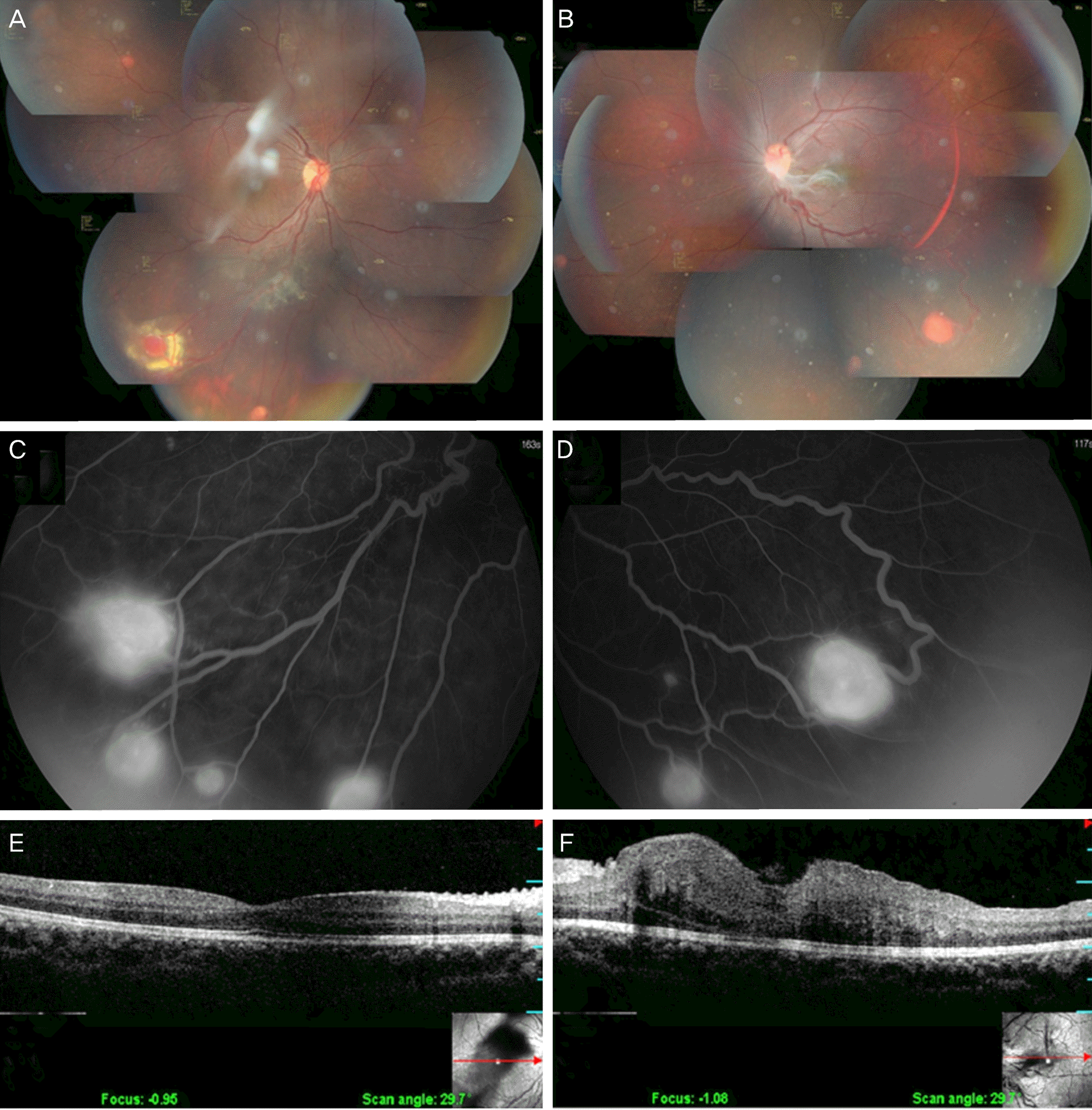
Figure 2.
(OS) Fundus photography (A) and optical coherence tomogram (OCT) images (B). Macular edema (ME) and epiretinal membrane (ERM) of the fovea was decreased (6th cessions after focal laser PC).
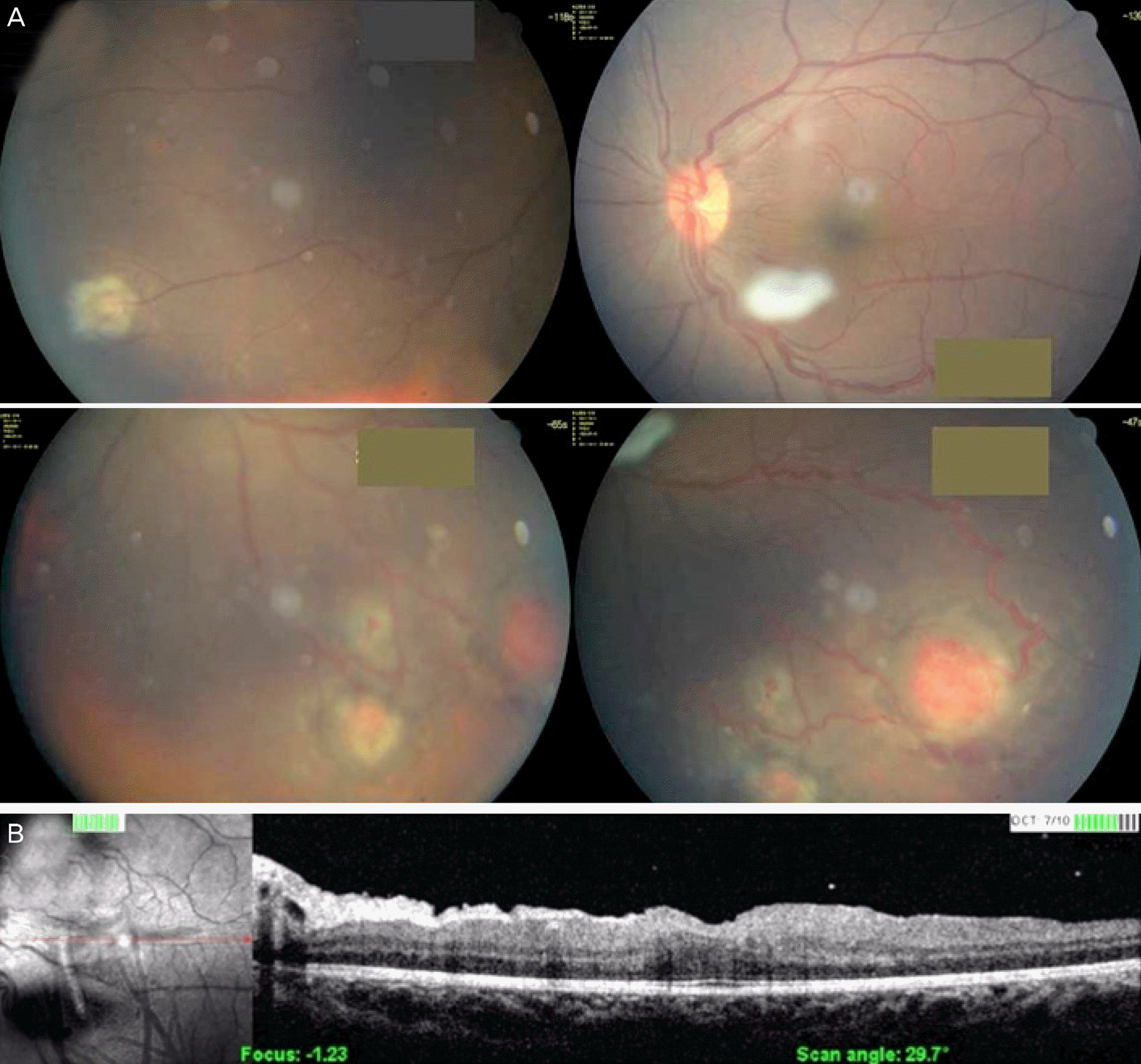
Figure 3.
(OS) Fundus photography (A) and optical coherence tomogram (OCT) images (B). Macular edema (ME) and epiretinal membrane (ERM) was exacerbated around the laser scars (7th cessions after focal laser PC).
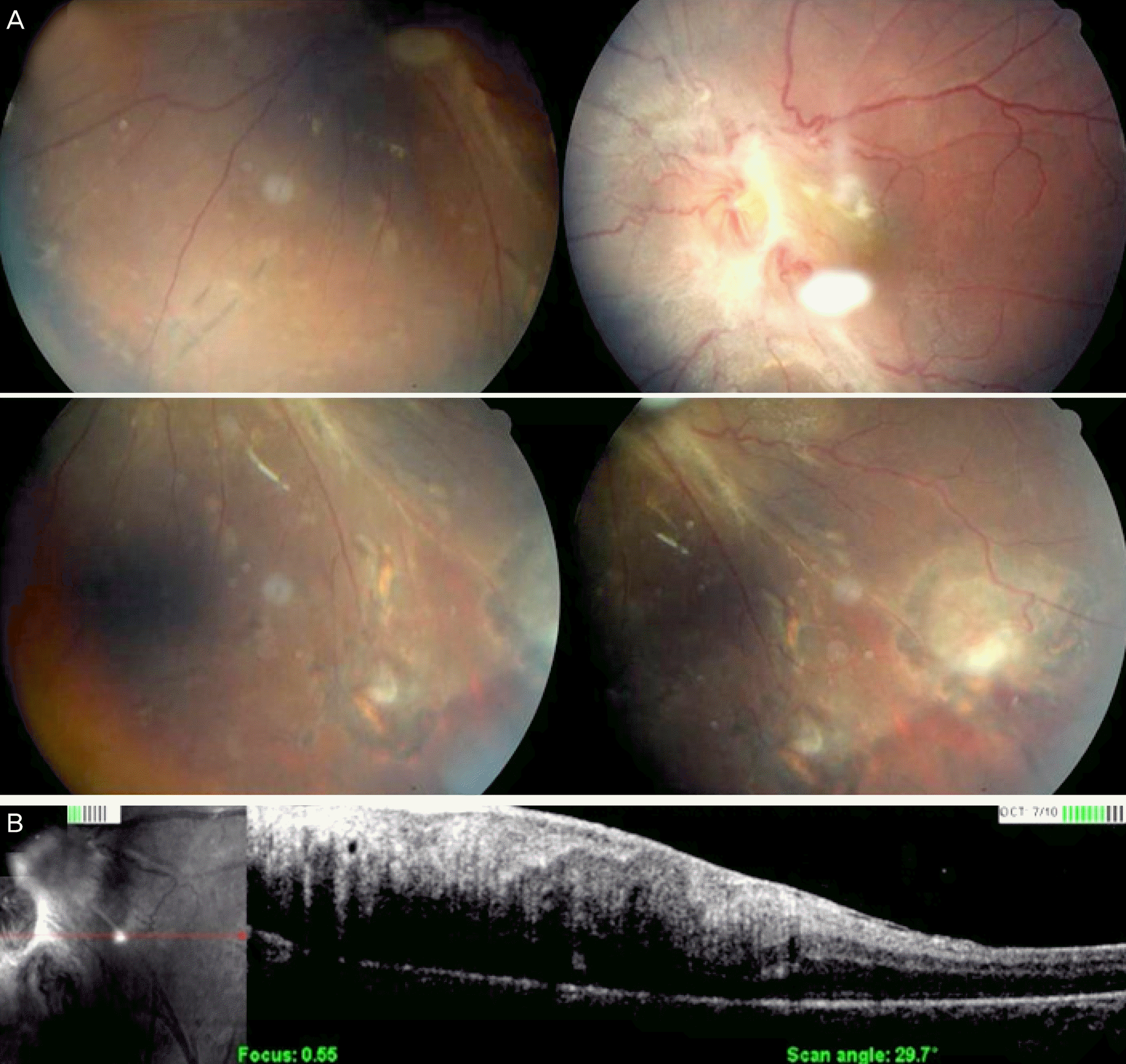
Figure 4.
Fundus photography (A) and optical coherence tomogram (OCT) images (B). Exacerbated epiretinal membrane (ERM) was noticed compared to the first visit.
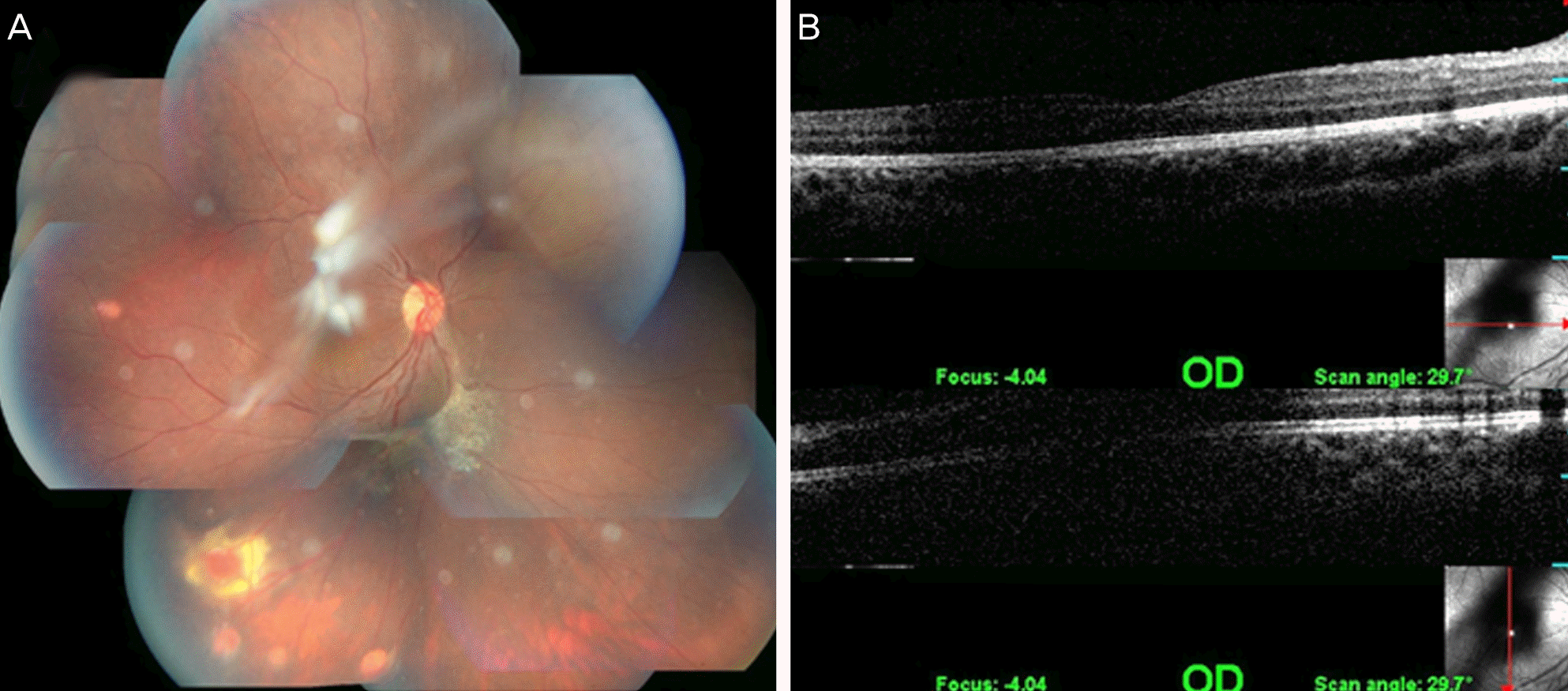
Figure 5.
Last visit (18 months after left eye surgery, 15 months after right eye surgery). (A, B) Fundus photography images. Remained stable lesion was inspected at the last visit. (C, D) Fluorescein angiogram demonstrating reduced fluorescence and leak-age associated with the lesion. (E, F) Optical coherence tomogram (OCT) of the fovea demonstrated decreased epiretinal membrane(ERM) and macular edema (ME).
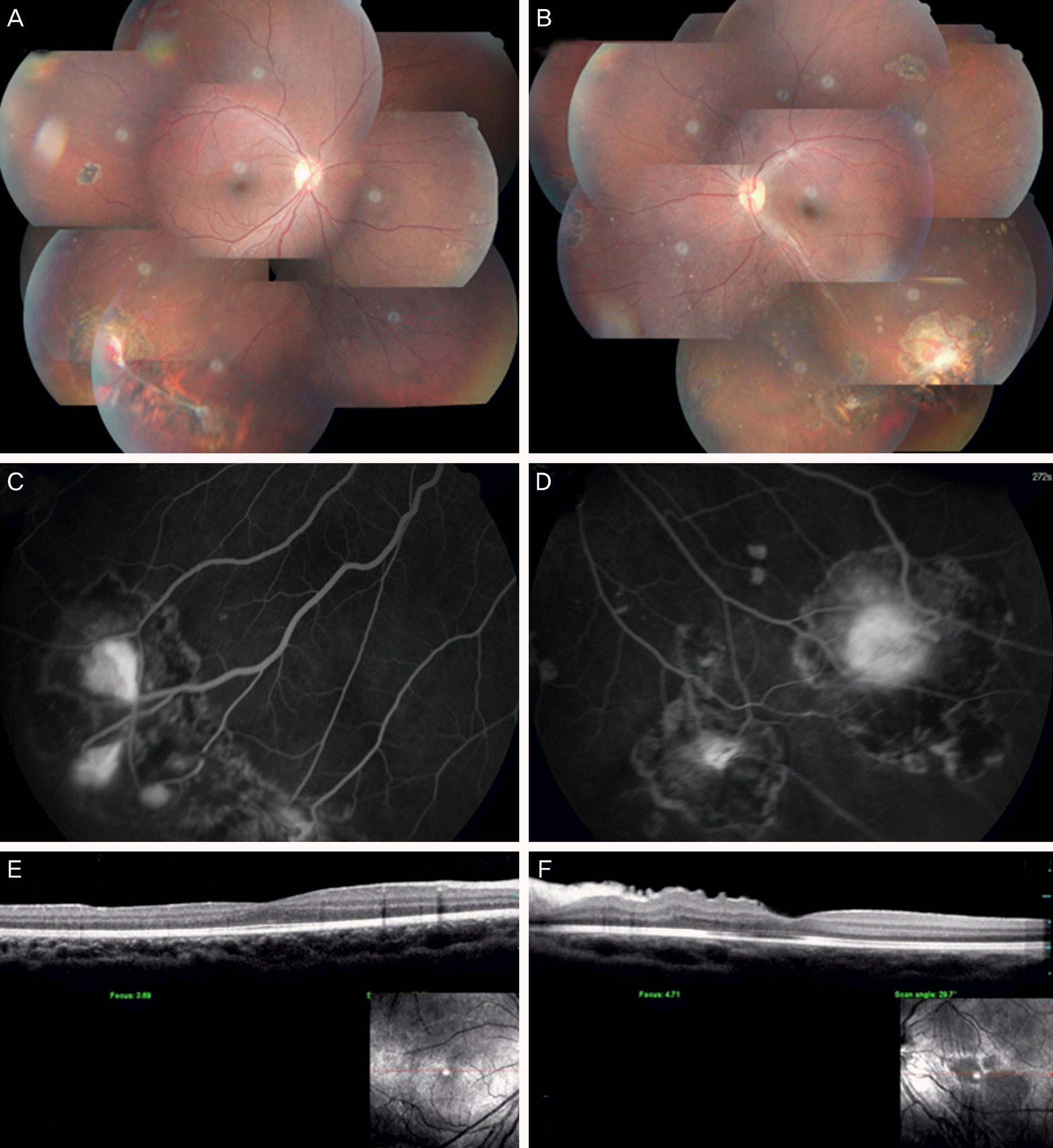




 PDF
PDF ePub
ePub Citation
Citation Print
Print


 XML Download
XML Download